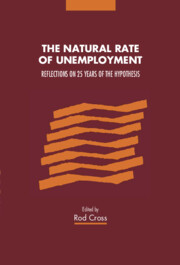Book contents
- Frontmatter
- Contents
- List of Contributors
- Preface
- 1 Introduction
- Part I The theoretical framework
- Part II Adjustment, ranges of equilibria and hysteresis
- Part III Empirical tests and macro models
- Part IV Political economy
- 15 Is the natural rate of unemployment a useful concept for Europe?
- 16 The natural rate of unemployment: a fundamentalist Keynesian view
- 17 Politics and the natural rate hypothesis: a historical perspective
- Index
16 - The natural rate of unemployment: a fundamentalist Keynesian view
Published online by Cambridge University Press: 03 May 2011
- Frontmatter
- Contents
- List of Contributors
- Preface
- 1 Introduction
- Part I The theoretical framework
- Part II Adjustment, ranges of equilibria and hysteresis
- Part III Empirical tests and macro models
- Part IV Political economy
- 15 Is the natural rate of unemployment a useful concept for Europe?
- 16 The natural rate of unemployment: a fundamentalist Keynesian view
- 17 Politics and the natural rate hypothesis: a historical perspective
- Index
Summary
Introduction
The theorising of the natural rate of unemployment (NRU) almost simultaneously by Phelps (1967) and Friedman (1968) was a significant step in the halt and ultimately reversal of the Keynes–neoclassical synthesis (neoKeynesian) in the field of macroeconomic theory as well as policy. Both Phelps and Friedman were of course reacting to the Phillips curve which in their view did not have sufficient grounding in neoclassical economics. The central issue was the seeming violation of the homogeneity postulate, since the Phillips curve purported to show a short-run, causal relationship between a nominal variable and a real variable. The neo Keynesians were uncomfortable with this because while they liked the macroeconomic simplicity of the Phillips curve, they also believed in the homogeneity postulate. The empirical/econometric connection between these ideas and the Phillips curve was made in two stages. In the first stage, Lucas and Rapping in two papers reversed the causal ordering between the rate of change of money wages (Δw) and the rate of unemployment (U) from that posited by Phillips, or rather more correctly by Lipsey (1960), (Lucas and Rapping, 1969, 1970; for the argument that Phillips did not have the same notion of causation that Lipsey and others have attributed to him, see Desai 1975, 1984). At this stage, price expectations were taken to be adaptive. In the second stage, Lucas engineered the creative union between rational expectations (RE) and the natural rate hypothesis (NRH), (Lucas, 1973).
- Type
- Chapter
- Information
- The Natural Rate of UnemploymentReflections on 25 Years of the Hypothesis, pp. 346 - 361Publisher: Cambridge University PressPrint publication year: 1995
- 2
- Cited by

